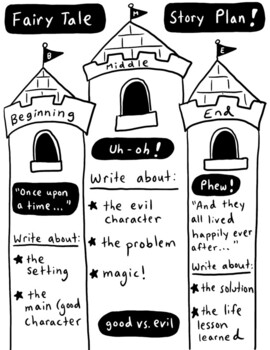How to Write a Fairy Tale - Fairy Tales Graphic Organizer - Distance Learning
- PDF
What educators are saying
Description
This unique and easy-to-use graphic organizer includes everything your students need to write a successful fairy tale narrative! Students will learn the common story elements and structure are found in fairy tales, plan their writing accordingly, and draft a beginning, middle and end. The best part of this structured way to teach narrative writing is the kid-friendly example pages, including a sample fairy tale story! From the graphic organizer and model pages, students will learn how to develop a setting, main (good) character, evil character, problem, solution and life lesson for their writing. Students will learn how to write a clear beginning, middle and end for their narrative. The graphic organizer also comes complete with a narrative writing transition words anchor chart and a revision and editing check-list! This graphic organizer works well with Common Core standards for narrative writing and is a structured and engaging remote learning, distance learning, or home schooling writing activity.





